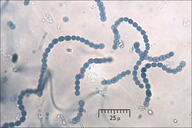|
|
click photo for larger file

Collema crispum
Crinkled Pulp Lichen
|
Photographer: Dr. Amadej Trnkoczy
ID: 0000 0000 0317 0344 (2017-03-04)Copyright © 2017 Dr. Amadej Trnkoczy
|
|
INFORMATION PROVIDED WITH THE PHOTO
|
date of photo Mar 2, 2017
latitude 46.36044 longitude 13.70373
View on Google Maps.
location
Lower Trenta Valley, between villages Soča and Trenta, right bank of river Soča, next to the path from Skokar farm house, Trenta 2 to cottage Trenta 2b, East Julian Alps (Posočje, Slovenia)notes Slo.: no name - syn.: Collema cheileum (Ach.) Ach. - Habitat: light wood, Fagus sylvatica, Picea abies, Juglans regia, Corylus avellana dominant; slightly inclined mountain slope, east-southeast aspect; calcareous, skeletal ground; mostly in shade, relatively warm place, partly protected from direct rain by tree canopies; average precipitations ~ 3.000 mm/year, average temperature 7-9 deg C, elevation 590 m (1.950 feet), alpine phytogeographical region. Substratum: mostly vertical surface of calcareous rocks of a stony fence along the path; sometimes associated with mosses. Comments: This find seems to fit well to the traits of (former) Collema crispum as described in Ref. 1 and 2. Morphological traits as well as substratum seem to be right. Also the picture published in Wirt (1995) (Ref.1), which is also cited as relevant in Smith et al. (2009) (Ref.2) shows great similarity with this find. The same seems to be true for the pictures published in Ref.5. The only objection may be, that in this find there are only a few flattened isidia seen. Apparently most of them are still young and hence +/- globose. Collema crispum doesn't seem to be a valid name any more. Recent molecular studies have changed taxonomy of jelly fungi (Collemataceae) drastically. The main morphological distinguishing trait between the largest and commonest genera Collema and Leptogium, that is thallus cortex character, is clearly proven not to be monophyletic. Phylogenetic molecular study (Otálora et al. 2013) (Ref.6) has been done (based on the best unconstrained trees), which resulted in some clades, for which there was no morphology supporting such a classification. In 2014 in order to reconcile morphology and molecular data, a new classification for Collemataceae was proposed (Ref.3). Based on slightly constrained topology ten clades were proposed. All of them can be characterized using a combination of traits as habitat preference, thallus habit, ascospore characteristics, thallus anatomical structure, and cortex. Now, following Index Fungorum the name Collema crispum (Hudson) Weber ex Wigg. is a synonym. Corresponding current name is Blennothallia crispa (Huds.) Otálora, P.M. Jørg. & Wedin, Fungal Diversity 64: 282 (2014). According to the key published in Otálora et al. (2014) (Ref.3) genus Blennothallia should have thallus with partially paraplectenchymatous medulla (a fungal tissue consisting of more or less isodiametric, rounded to angular cells) and Nostoc photobiont in short chains with less than 3 cells. Both traits clearly do not correspond to my find. According to the key the observed non-paraplectenchymatous medulla and very long Nostoc chains speak in favor of (new) Collema or (new) Lathagrium genus. But Collema is now mainly a corticolous genus and my find is strictly saxicolous. Also in the list of species C. crispum doesn't exist. Similarly in the (new) genus Lathagrium the name L. crispum does not exist. Also, for (new) genus Lathagrium very frequent apothecia are characteristic. But I haven't found a single one on more than ten specimens carefully checked. Thus I don't know how to properly name this find (even not to genus level). I will stay with old Collema crispum although it is possible that this find is not that or that I missed something in this complex naming issue? Any help or idea is very much welcome. Thallus loosely attached to the rock by scattered whitish hapters; photographed in wet state after rainy days; isidiate; blackish-brown and fragile when dry. Thallus up to 20 x 5 cm large but usually much smaller; many (>20) specimens present all along the stony fence. Herbarium: Mycotheca and lichen herbarium (LJU-Li) of Slovenian Forestry Institute, Večna pot 2, Ljubljana, Index Herbariorum LJF Ref.: (1) V. Wirth, Die Flechten Baden-Württembergs, Teil.1., Ulmer (1995), p 354. (2) C.W.Smith, et all, The lichens of Great Britain and Ireland, The British Lichen Society, (2009), p 349. (3) Otálora, M., Jørgensen, P., Wedin, M. (2014) A revised generic classification of the jelly lichens, Collemataceae, Fungal diversity, 64:: 275-293 available at: http://www.diva-portal.org/smash/get/diva2:693928/FULLTEXT03 (4) F.S. Dobson, Lichens, The Richmonds Publishing Ca.LTD (2005), p 151. (5) http://nhm2.uio.no/botanisk/cgi-bin/lav_foto.pl?gen=Blennothallia&sp=crispa zelo podobne slike (6) Otálora MAG, Aragón G, Martínez I, Wedin M (2013) Cardinal characters on a slippery slope - a reevaluation of phylogeny, character evolution, and evolutionary rates in the jelly lichens (Collemataceae s. str). Mol. Phylogenet. Evol. 68:185-198 (available at: https://www.diva-portal.org/smash/get/diva2:677720/FULLTEXT01.pdf)camera AmScope MA500 digital
contributor's ID # Bot_1034/2017_DSC6822 photo category: Fungi - lichen
|
MORE INFORMATION ABOUT THIS FUNGUS
|
| common names
Crinkled Pulp Lichen (photographer)
View all photos in CalPhotos of Collema crispum Check Google Images for Collema crispum |
|
The photographer's identification Collema crispum has not been reviewed. Click here to review or comment on the identification. |
|
Using this photo The thumbnail photo (128x192 pixels) on this page may be freely used for personal or academic purposes without prior permission under the Fair Use provisions of US copyright law as long as the photo is clearly credited with © 2017 Dr. Amadej Trnkoczy.
For other uses, or if you have questions, contact Dr. Amadej Trnkoczy amadej.trnkoczy[AT]siol.net. (Replace the [AT] with the @ symbol before sending an email.) |
|
|
